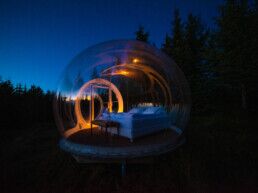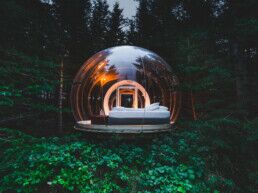- Home
- Travel Guide
- Exploring 11 Spectacular Iceland Canyons
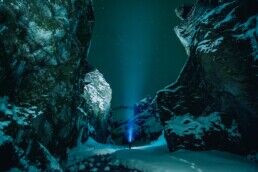
Let’s take a trip through Iceland canyons, each with its own cool story. Picture valleys that have been around forever, shaped by huge glaciers from way back and the drama of volcanoes. Visiting Iceland isn’t just about seeing massive glaciers or watching volcanoes erupt. It’s also about checking out the awesome landscapes they leave behind.
Think of these Iceland canyons as nature’s own art pieces, created over thousands of years by ice and fire, with a little help from water and wind. They’re like nature’s own marks on the landscape, and each one is unique.
These canyons are not just pretty sights; they’re like an open invitation to explore. You can see them in all sorts of ways – join a group and tour the highlands, drive around by yourself, or even just rent a car and go where the road takes you. Trust me, these Iceland canyons will leave you as amazed as the natural forces that made them.
Ensuring Your Safety: Essential Tips for Exploring Iceland Canyons
When you’re gearing up for these Iceland canyons, here’s the lowdown on staying safe:
First off, weather’s a wildcard there, even when it’s not winter. Check the forecast, make sure no red flags are waving in your area.
Now, about your footwear game—it’s gotta be strong. Those canyon floors can be tricky, with rocks doing their own thing and spots getting slick. Trekking poles might just be your new best friends for some added stability.
Heads-up: as enticing as those cliff edges look, they can be risky. Some of them just crumble away, and you don’t want to be caught in that scene.
Nature appreciation 101: take your trash with you, and give the local flora and fauna some space to do their thing. They’re fragile, after all.
Lastly, if you’re venturing way off the grid, have a travel plan sketched out. It’s like a safety net if your adventure takes a wild turn.
Best time to Visit Iceland Canyons
Looking to visit Iceland’s awesome canyons? Wondering when’s the best time to go? It’s a common question, and there’s no one-size-fits-all answer, but here’s some food for thought:
Remote Iceland Canyons in Winter? Maybe Not: A lot of the really breathtaking canyons are off the beaten path. In winter, getting to these spots can be tough, or even impossible. So, if you’ve got your heart set on a canyon in the Highlands or another out-of-the-way place, summer’s probably your best bet.
Winter Wonderland vs. Summer Splendor: Here’s the thing – Iceland canyons do a complete 180 from winter to summer. In winter, you get this dramatic, snow-covered landscape, with frozen waterfalls – it’s like something out of a fairy tale. Come summer, it’s a whole different world: vibrant greenery, wildflowers everywhere. Same place, totally different vibes.
So, it really comes down to what kind of experience you’re after. Both seasons have their own unique magic to offer.
11 Best Iceland Canyons to Check Out
Iceland’s full of natural wonders, and with so many canyons, everyone’s got a few they love. We’ve picked some of our top spots.
Just a heads up, our list isn’t covering all the bases. If your go-to Iceland canyon isn’t here, stay tuned for our honorable mentions at the end!
11. Valley of Tears: Sigoldugljufur Canyon
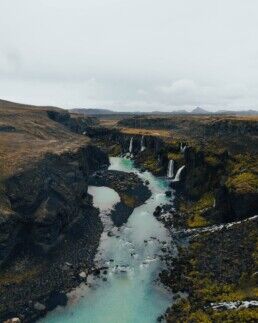
They call it the “Valley of Tears,” but Sigoldugljufur is anything but sad. It’s a stunning spot in the Icelandic Highlands, known for its bunch of waterfalls. The blue waters and greenery add a splash of color that’s just beautiful.
It’s a bit out of the way compared to other places on our list, which means it’s not as crowded. So, you can enjoy its almost magical landscape in peace.
Sigoldugljufur’s pretty unique – it’s a newbie as far as Iceland canyons go. It used to be part of a glacial river before they built a hydroelectric plant nearby. So, you could say it’s a man-made canyon!
Getting to Sigoldugljufur Canyon
Check out this map. Sigoldugljufur’s in the central highlands. You’ll need a four-wheel drive to get there. It’s only open in summer. Start from Hella, hit Road 26 off the Ring Road, and drive about 50 miles (82 kilometers) to F208 Mountain Road. That road will lead you straight to the canyon.
10. Nature's Majestic Chasm: Almannagja Gorge
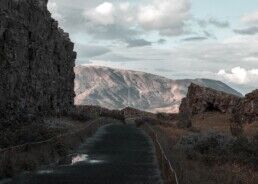
Almannagja is a spot that’s both interesting for its history and its geology, sitting right in Thingvellir National Park. It’s part of the Golden Circle, making it the most visited out of all Iceland canyons.
This canyon isn’t super long, just under a mile, but it’s right on the Mid-Atlantic Ridge. That’s where the North American and Eurasian tectonic plates are slowly moving apart. Seeing this divide up close is something special and a big reason people visit Almannagja.
But it’s not just about rocks and rifts. Almannagja’s got a lot of history too. It was the gathering place for the Althing, the oldest parliament that’s still going. When you’re there, it almost feels like you can hear the old law speakers.
Getting to Almannagja Gorge
It’s pretty easy to get to from Reykjavik, less than an hour’s drive. Just head on Route 36 straight to Thingvellir National Park.
And if you’re thinking of visiting, there are loads of Golden Circle Tours to choose from. Whether you want something thrilling like snowmobiling or something chill like combining it with a trip to the Secret Lagoon, there’s a tour for you.
9. A Serene Natural Escape: Stakkholtsgja Canyon
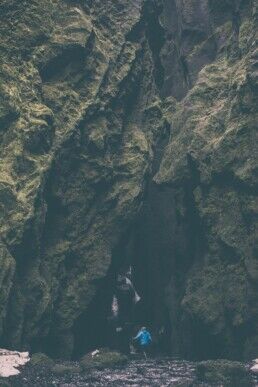
Nestled in the Thorsmork Nature Reserve in South Iceland, there’s a canyon called Stakkholtsgja that’s like something out of a storybook. It’s a bit of a hidden gem and a real treat for adventurers.
The canyon stretches just over a mile and can get as deep as 330 feet (100 meters). With streams winding through it, the whole place has a peaceful, almost magical vibe. Walking between those high cliffs feels like stepping into a fairy tale world.
And then there’s the waterfall – the real star of Stakkholtsgja. Finding it feels like uncovering a hidden treasure at the end of a rewarding journey. It’s hard to put into words, but it’s an experience you won’t forget.
Getting to Stakkholtsgja Canyon
You’ll find Stakkholtsgja in the Thorsmork Nature Reserve, reachable only in summer. You’ll need a four-wheel drive to get there. Head on the F249 Mountain Road off the Ring Road. You’ll come to a river crossing – make sure your vehicle can handle it and that conditions are good. After crossing, keep going towards Thorsmork Valley and look out for the parking area.
8. Hidden Sanctuary: Nauthusagil Ravine
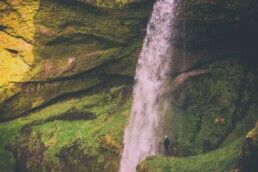
Hidden away under the Eyjafjallajokull glacier volcano, you’ll find Nauthusagil, a narrow but stunning ravine. It’s one of those places you have to see to believe.
Stepping into Nauthusagil is like entering a whole new world. Tall cliffs and lush greenery wrap around you, setting the stage for an adventure. What really stands out is the wild rowan tree clinging to the ridges above.
There’s a little stream running along the canyon floor. You might need to be a bit nimble to cross it, but it’s worth it. At the end of Nauthusagil, you’re rewarded with a beautiful waterfall. It cascades down in a natural funnel in the cliffside, creating a misty wonderland, especially when the sun peeks through from above.
Getting to Nauthusagil Ravine
Nauthusagil is off the F249 Mountain Road, the same one you take to Thorsmork Nature Reserve. If you’re renting a car, just remember: don’t try to go in winter unless you’ve got a four-wheel drive.
7. The Grandeur of Iceland's Rift: Eldgja Canyon
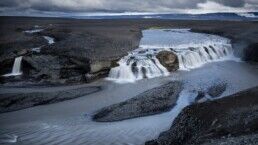
Eldgja, or “Fire Canyon” in Icelandic, is an incredible volcanic canyon in the Highlands. It’s massive, stretching over 25 miles (40 kilometers) and reaching depths of up to 880 feet (250 meters). It’s actually one of the biggest volcanic canyons in the world.
Hiking through Eldgja is a chance to really see Iceland’s wild side. It runs alongside the Lakagigar craters, known for their huge eruptions over the years.
Visiting Eldgja is like stepping back into Iceland’s volcanic history. It’s awe-inspiring to see just how powerful nature can be. Plus, it’s home to Ofaerufoss, a stunning, multi-tiered waterfall that flows right through the volcanic landscape.
Getting to Eldgja Canyon
Eldgja’s up in the highlands, so it’s a summer-only trip. You’ll need a four-wheel drive – the road’s a bit rough, but totally worth it. Start on Route 1, switch to Road 208, and then it turns into the F208 Mountain Road.
Keep on the F208 until you see a sign for Gjatindur, which leads you to Eldgja. Or, if driving’s not your thing, check out this epic 8-hour super jeep tour. It’s a great way to see the sights without the stress of driving.
6. A Hiker’s Paradise: Thakgil Canyon
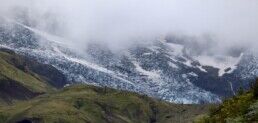
Thakgil is this really picturesque gorge in South Iceland, right near the Myrdalsjokull glacier. It’s full of these jagged rocks that can look like just about anything if you’ve got a bit of imagination.
It’s about 12 miles (20 kilometers) northeast of Vik, and a lot of people say Thakgil’s a bit of a hidden treasure. There’s a nice campground there with all the basic stuff you need. It’s a perfect spot to set up camp if you’re planning to explore the hiking trails around the area.
Thakgil’s surrounded by these tall mountains that give you a bit of a break from the weather. It’s like stepping into another world with soft moss, secret caves, amazing waterfalls at the bottom, and if you climb up a bit, you get these incredible views of the glacier.
Getting to Thakgil Canyon
Thakgil’s about a 40-minute drive from Vik. Just take Road 214 off Route 1, and it’ll lead you right to the campsite. The road’s gravel, so drive carefully, but it’s not too tricky.
5. Nature's Sculpted Beauty: Mulagljufur Canyon
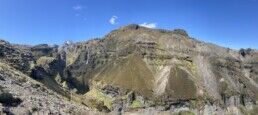
Mulagljufur is this kind of secret canyon at the edge of southeast Iceland. It’s a bit tricky to find since there aren’t any signs pointing the way, but those who’ve stumbled upon it swear it’s a must-see.
It’s a hit with hikers. Mulagljufur has these narrow paths weaving through rugged cliffs blanketed in green moss and wildflowers. The tall cliffs and the peaceful natural surroundings make it a real tranquil spot, away from the usual tourist trails.
The canyon’s got not one, but two amazing highlights: the Hangandifoss and Mulafoss waterfalls. Even though they’re some of the tallest in Iceland, they’re kind of a well-kept secret because of their off-the-beaten-path location.
Getting to Mulagljufur Canyon
It’s a bit of a drive from Reykjavik, about 231 miles (372 kilometers), which takes around 4 hours and 30 minutes. Just head out on the Ring Road, and it’ll get you to the start of the canyon.
4. The Symphony of Water and Stone: Jokulsargljufur Canyon
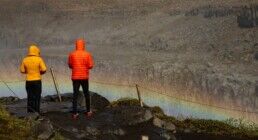
Jokulsargljufur is one of those awe-inspiring canyons you find in Northeast Iceland. Carved out by a glacier-fed river and stretching over 15 miles, it really shows off the incredible force of nature.
The canyon is famous for its waterfalls, especially Dettifoss, which is the second most powerful in Europe. It’s a sight to see with a massive water flow of 1,970 cubic feet (183 cubic meters) and is a real symbol of Iceland.
But there’s more to Jokulsargljufur than just waterfalls. Take Hljodaklettar, for instance. It’s this amazing rock formation made of basalt columns and odd shapes that create weird echoes – that’s why it’s called “Echo Rocks.”
Getting to Jokulsargljufur Canyon
Jokulsargljufur’s up in the north. If you’re in East Iceland, like around Egilsstadir, or in North Iceland, near places like Akureyri, Husavik, or Lake Myvatn, it’s pretty convenient.
Driving the Ring Road? You can reach the canyon by turning onto Road 862 or 864. Or, if you prefer not to drive, check out this guided tour of North Iceland. It includes Dettifoss, Lake Myvatn, and Godafoss – a great way to see the area.
3. The Mythical Canyon: Asbyrgi Canyon
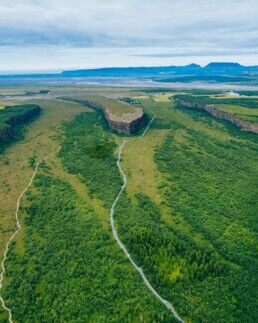
Asbyrgi is a kind of magical canyon in Northeast Iceland, shaped like a huge horseshoe. There’s an old legend that says it was formed by Sleipnir, Odin’s eight-legged horse from Norse mythology. When you see the place, you might start believing in myths too.
The canyon stretches over two miles and is ringed by cliffs towering over 300 feet high. Inside, you’ll find a patchwork of colorful trees – a real treat for anyone who loves nature. And there’s this big rock formation, Eyjan or “The Island,” that splits the canyon almost in half, giving it its unique look.
For the geology buffs, Asbyrgi started forming about eight to ten million years ago, after the last Ice Age. It was probably shaped by massive floods following a volcanic eruption under the Vatnajokull glacier.
There are loads of hiking trails around Asbyrgi, like the one leading to Botnstjorn pond, right in the canyon’s heart. The quietness there, with just the sound of birds and the whisper of the trees, is something special.
Getting to Asbyrgi Canyon
Asbyrgi’s not far from Husavik, just off Road 85, which links up with the Ring Road. It’s part of the Diamond Circle, so there are plenty of tours from North Iceland, like this amazing 9-hour Diamond Circle tour, if you’re up for it.
2. Nature's Carved Marvel: Fjadrargljufur Canyon
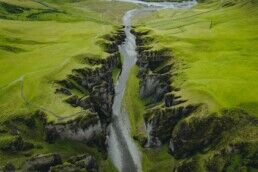
Fjadrargljufur, down in southern Iceland, is a real gem that’s starting to get noticed. The trail there gives you these incredible views in every direction, making it a real hit in Iceland.
This place looks different with its cool shape—steep cliffs, waterfalls everywhere, and these rough rocks making it all interesting. It’s like nature crammed tons of beauty into this tiny 1.2-mile spot.
This canyon got famous thanks to Justin Bieber shooting his “I’ll Show You” music video here. That put it on the map for everyone.
But with all the people coming, they got worried about the plants and stuff. So, they had to shut it down for a bit to let things grow back. Now they want folks to stick to the paths and not mess around on the cliffs.
Getting to Fjadrargljufur Canyon
To get there, just head from Kirkjubaejarklaustur town on Road 206 off the Ring Road. And while you’re around, maybe try cruising on a Glacier Lagoon boat ride—it’s pretty cool.
1.Otherworldly Marvel: Studlagil Canyon
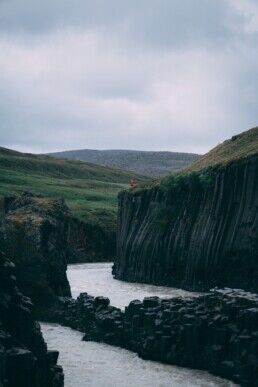
“Is that for real?” is often the reaction when folks see Studlagil in pictures. It’s a real wonder, with its stunning blue-green river and a bunch of basalt rock columns that beat anywhere else in Iceland.
Tucked in East Iceland, Studlagil was shaped by a strong glacial river slicing down from the highlands. Being way out there and hard to reach, it stayed a bit of a secret for a while.
What makes Studlagil special? It’s those basalt columns. Like the ones at Reynisfjara black sand beach, but here, there’s a ton more. When lava cooled down, these columns formed cool patterns, making the canyon walls stand out. Nearby, there’s Studlafoss waterfall, also surrounded by these columns.
That river’s color is wild! It gets that magical hue from melted ice off the nearby glaciers. As it flows through the canyon, it carries tiny bits of dirt and minerals, giving the river this mesmerizing look. There’s this cool 7-hour nature tour that really shows off those colors.
Studlagil feels like someone built a Gothic cathedral on purpose, not just nature doing its thing. The vibrant river against those rough cliffs makes it our top pick for the prettiest Iceland canyon.
Getting to Studlagil Canyon
Getting to Studlagil Canyon’s a bit of a haul—it’s way out in East Iceland, a long way from Reykjavik. You’ll want to drive along the Ring Road and then take Road 923. After a while, you’ll spot the entrance to Jokuldalur Valley. Park your car and take a stroll the rest of the way.
Discovering Lesser-Known Iceland Canyon Treasure
While our top 11 canyons in Iceland are truly breathtaking, there are a few more stunning ones that almost made the cut.
Check these out:
Glymur: It’s Iceland’s second-highest waterfall and comes with a beautiful canyon. Super easy to get to by foot and not far from Reykjavik. No wonder it’s a hotspot for hikers.
Raudfeldsgja Gorge: This one’s a hidden gem on the Snaefellsnes Peninsula. Covered in moss, with narrow cracks and a little waterfall—a recipe for a thrilling adventure.
And then there’s Kolugljufur up in North Iceland. Loads of gorgeous waterfalls in this gorge, even though it’s not that well-known. But once you see it, it sticks with you.

Robert Robertsson
Hey, I'm the founder of Airmango. My love affair with travel and entrepreneurship kicked off in 1994 in Iceland. Fast forward through two decades, and I've been lucky enough to weave my career through five different countries. Each place has left its mark on me, not just in my personal life, but in how I approach business too. With Airmango, I'm bringing all those global insights and experiences to the table – it's like seeing the world through a business lens.
